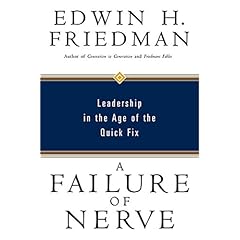A Failure of Nerve (in leaders and editors alike)

Edwin H. Friedman, A Failure of Nerve: Leadership in the Age of the Quick Fix. New York: Seabury Books, 2007. 260pgs
Introduction: I'm pretty sure this isn't a trend, but here is my second book review and it happens to be of another work published posthumously. Friedman was working on this book when he died in 1996. Three years later, it was published privately (what of it there is, including an introduction, epilogue, 5 completed chapters and 3 incomplete chapters. Apparently this is the entire book in outline, but not in the content of each chapter). In 2007 it was published on a larger, public, scale.
Summary: In this book, Friedman argues that the current lack of leadership in America is a symptom of the regressive emotional processes reigning in our culture. To do this, Friedman compares modern day America to Medieval Europe before the renaissance, arguing that despite our technological advances we are in much the same place now as then. The positive assertion which arises from this is that with proper leadership we can move forward. With this in mind, Friedman describes three imagination limiting factors which dominate our world-view: A focus on data rather than decisiveness and maturity (ch. 3), an orientation towards empathy instead of responsibility, with an attendant focus on, and conformity to, weakness rather than strength (ch. 4), and the confusion of self with selfishness (ch. 5). Throughout these chapters, Friedman also introduces and explores new relationship models which help us move past these limiting factors. From these new models, Friedman proposes a new model of leadership (ch. 6), new understandings of emotional processes within organizations (ch. 7), and new ways of looking at, and dealing with, crises and sabotage (ch. 8). His main point is that what we need is leaders who focus on their own self-differentiation and on being able to maintain proper distance within the system he or she is leading.
Negative Criticism: This books largest problems stem from the fact that it was unfinished. It is not so much that I wished the chapters were finished, (though I did wish that, I also know that this is simply a fact of the book). Its more that I wish the editors had had the nerve to do their job despite this fact. The book is riddled with repetitive material, poor organization, and completely lacks in making the obvious references to Friedman's earlier writings. That said, I am not sure I could have done much better. How do you edit a work properly without interaction with the author? Furthermore, Friedman warns the reader in the beginning that the chapters overlap, and that understanding what comes later will aid in reading what is placed first. I suppose one is only left wishing that this were not so true, or that one could grasp the book in its entirety all at once.
Positive Response: That said, the content of the book is highly thought provoking. Friedman's ideas are, without a doubt, revolutionary and, in my opinion, largely correct. For myself, the most stunning part was when he compare the normal leadership 'superstitions' with what he considers more proper guidelines. I have placed this comparison below (from page 194).
1. Leaders influence their followers by the model they establish for identification or emulation.2. The key to successful leadership is understanding the needs of the their followers.3. Communication depends on one's choice of words and how one articulates them.4. Consensus is best achieved by striving for consensus.5. Stress is due to hard work.6. Hierarchy is about power.
Before I list the contrasting views, let me just say that I have operated with all of those assumptions. They make perfect sense, don't they? Friedman contrasts them with the following list.
1. A leader's major effect on his or her followers has to do with the way his or her presence (emotional being) affects the emotional processes in the relationship system.2. A leader's major job is to understand his or her self.3. Communication depends on emotional variables such as direction, distance, and anxiety.4. (this is implicit within his writing, though not in this list, and thus not a direct quote, unlike the rest of these points): Consensus is not our goal, raising the maturity level of our followers is the proper goal. Conform to strength not weakness.5. Stress is due to becoming responsible for the relationships of others.6. Hierarchy is a natural systems phenomenon rooted in the nature of protoplasm.
Conclusion: This is a must read for anyone in, or interested in, leadership. This is especially true if you have spent much, or any, time reading some of the more popular leadership literature, and even more especially true if that literature has frustrated you. Perhaps the most important group of people who ought to read this are those who have wondered why in the world there is so much of this literature on leadership! I happen to fall into all of those categories. A few caveats though: Be prepared for some slogging, with the repetition and such. Also, be prepared for frustratingly quick endings to the unfinished chapters. There is still a lot in those chapters, but if your like me you won't be able to keep yourself from thinking "what if?"
Comments